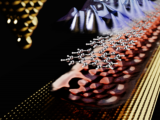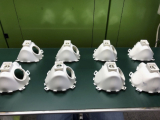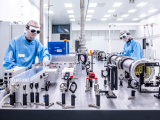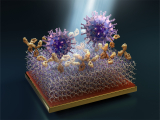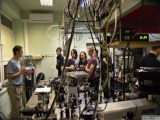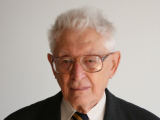The recently deceased Ing. Ludvík Smrčka DrCs, an excellent researcher and a friend, as remembered by his co-workers Pavel Středa, Petr Vašek, Pavel Svoboda and Jan Kočka. Ludvík Smrčka left an indelible mark on their professional and private lives.
You are here
News
An international team of scientists, involving researchers from the Regional Centre of Advanced Technologies and Materials (RCPTM), the Faculty of Science, Palacký University Olomouc, and the Institute of Physics of the Czech Academy of Sciences (FZU), has designed and experimentally verified the possibility of preparing single-dimensional, carbon-based conductive polymers. As carbon is one of the most abundant elements, new polymer conductors have potentially lower production costs than normal metal conductors, along with greater stability and the opportunity to control their material properties. The joint work of Czech, Spanish and Swiss scientists, which was published this week in the journal Nature Nanotechnology1, introduces a novel approach to designing non-metallic conductors, which could be used in solar energy applications, optical technologies or nanoelectronics. The work is so important that the editors of Nature Nanotechnology included a special commentary on the article in their News & Views.
Next week, CARDAM - a daughter company of the FZU, and Beneš a Lát a.s., and České zbrojovky a.s. are going to launch a serial production of RP95-M semi-mask intended for a higher-protection class. Its design is based on an original model developed by the Czech Technical University (ČVUT). As compared to the provisional production using 3D printing method, the manufacture of key parts will be complete in several seconds instead of several dozens of minutes. At the same time, the mask will improve in quality and will be less expensive.
The discovery of the ruby laser by Theodore Maiman in Malibu, CA on 16 May 1960, triggered extensive work around the world to make lasers. In the former Czechoslovakia, the first laser was successfully designed, built and operated at the Institute of Physics of the Czechoslovak Academy of Sciences in Prague. Karel Pátek (5. 5. 1927 – 25. 11. 1967), a distinguished research scientist working in the Department of Luminescence of the Institute, registered 1064-nm laser action in an optically-pumped Nd:glass rod on 9 April 1963. Pátek’s group studied a variety of different Nd3+ doped glasses using a number of experimental and theoretical techniques and, together with Jaroslav Pantoflíček at the Charles University in Prague, obtained valuable results in this area.
A technology developed by a team of researchers, led by Hana Lísalová from the Department of Optical and Biophysical Systems of the Institute of Physics of the Czech Academy of Sciences, should enable to detect SARS-COV-2 virus particles directly - in contrast to the demanding detection of antibodies in patients' bodies.
He started out as a participant of the Young Physicists Tournament but he gradually transitioned from being a participant to being a juror and, momentarily, contributes to the event as one of its organisers. He would like to teach the young talents that research does not start by substituting into a formula and does not end by resolving a research problem. A great deal of success lies in the ability to formulate a research problem, and, above all, to present the results of the research to experts as well as the public. This applies equally to the Young Physicist Tournament which, together with his scientific activities at the Institute of Physics, belongs to his affairs of the heart.
A team of Czech scientists demonstrated for the first time a controlled transfer of electron within one molecule. The work published in the journal Nature Communications brings important knowledge not only about one of the key processes in physics, chemistry, and biology but also provides inspiration for the construction of quantum computers based on molecular cellular automata or super-capacitors for storing energy in individual molecules.
One of the prerequisites for worker satisfaction is their being able to balance their work and family life at the workplace. An uneasy task for which the Institute of Physics, as an employer, has looked for and found an effective solution. The emergence of Visitors‘ Rooms for adults with children across the centres of the Institute of Physics has put wide smiles on parents‘ and their children‘s faces.
Stanislav Šafrata may be considered without exaggeration to be the founding father of cryogenics and low-temperature physics in the former Czechoslovakia. He was born on 9 September 1925 in Osturňa. Later, he attended a grammar school in Bratislava, Slovakia, and a Higher Industrial School in Prague. In 1949, he graduated from the Faculty of Natural Sciences of Charles University in Prague, where he completed his additional scientific training in physics three years later. The scope of his scientific expertise and activities was always very broad as evidenced by a monography co-authored with V. Petržílek: Electricity and Magnetism, published in 1953.
Cosmic acceleration and Dark energy might not exist. The dispute of professor Subir Sarkar about the significance of the supernovae evidence presented by the 2011 Nobel Prize teams continues. One of the hot topics at the workshop Multimessengers@Prague, where we met.
Pages
Short news
Institute and media
Česká televize ČT24, 7.4.2020.
Skupina Hany Lísalové z oddělení...
Velké významné infrastruktury, 22.11.2019.
This year marks the...
Uniwersytet Opolski 21.10.2019.
J. Krása (Institute of Physics...
Ferroelectrics, 11.2.2019.
It is with much pleasure that I...

